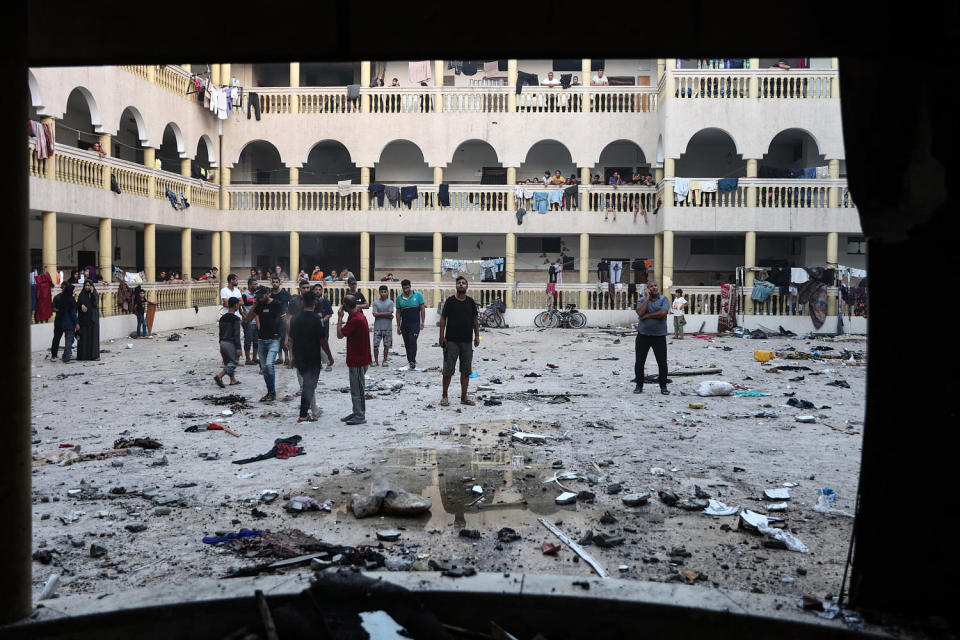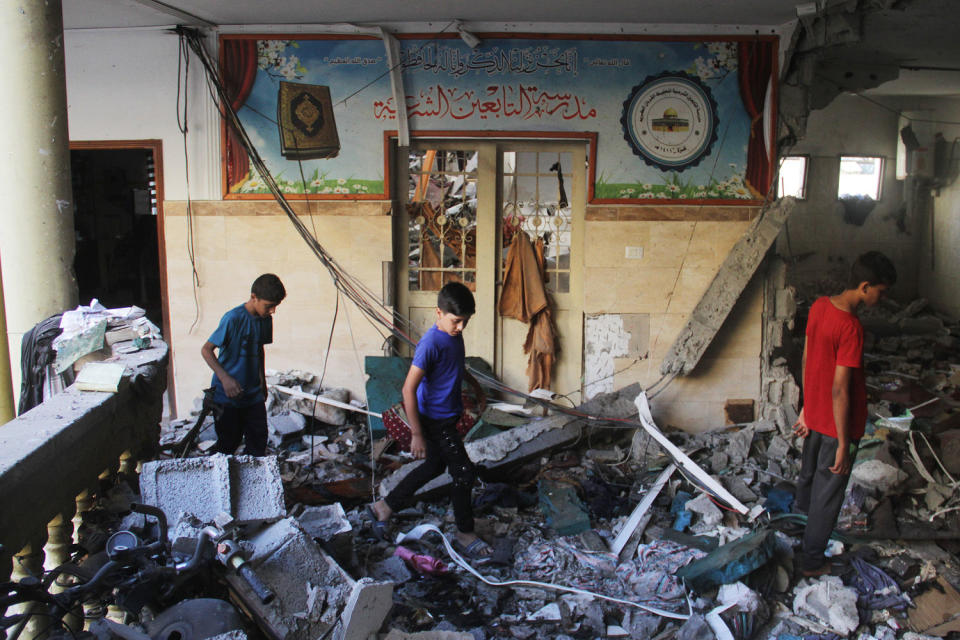A charity taught children strike drills in a school compound. Days later, Israel attacked it.
Young children sat on the carpeted floor of a Gaza City classroom, wrapping their hands around their heads as they learned, during a non-profit organization’s training program, how to brace for the impact of an airstrike.
Days later, on Aug. 10, the Israeli military bombed part of the school. At least 93 people were killed, according to local officials.
Israeli officials said their intelligence indicated that no women and children were in the area they targeted with three high-precision bombs: a mosque in the Tabeen school compound. In video and photos of the school, the mosque appeared to be connected to the school building, where displaced Palestinians were sheltering.
But leaders of the charity Humanity & Inclusion told NBC News that the Israel Defense Forces should have been aware of the risks of striking a compound where civilians were sheltering.

In the days before, Humanity & Inclusion notified IDF coordinators in writing of its plans to visit the school inside the Tabeen building on Aug. 6 and Aug. 8 for humanitarian work, according to communications reviewed by NBC News and a top official at the nonprofit.
“I’m highly surprised that the IDF would not know that this place, this school, was used as a shelter for civilians,” Federico Dessi, the Middle East regional director for Humanity & Inclusion, a Lyon, France-based charity that works in dozens of countries around the world responding to conflicts and disasters, said in a phone interview on Aug. 16.
Israel’s Gaza Coordination and Liaison Administration approved both trips, and the charity coordinated their trips with the United Nations Office for the Coordination of Humanitarian Affairs (OCHA), he added.
While the charity did not outline the exact purpose of its visits in the requests, Dessi said he believed “the information provided was enough to indicate to the
Israel’s Gaza Coordination and Liaison Administration and the IDF more in general, that Humanity & Inclusion’s team were planning to conduct humanitarian work at the school.”

Humanity & Inclusion’s team in Gaza was aware of civilians at the site since at least April — and that roughly 1,400 non-combatants were thought to be sheltering there, including more than 480 children under the age of five, he added. The Gaza Civil Defense agency suggested the number of people sheltering at the facility, which had served as an Islamic school for boys prior to being transformed into a shelter, was higher, telling NBC News they believed thousands of people had been seeking refuge there.
OCHA spokesperson Jens Laerke said the agency does not confirm notifications made on the Humanitarian Notification System, which is used to inform parties to the conflict about the locations of humanitarian sites and movements.
But, he said, the “requirement to spare civilian assets is enshrined in international law,” he added, and should apply regardless of whether the locations of humanitarian sites have been shared through the system.
In a statement on the day of the bombing, the IDF said it had targeted a Hamas command-and-control center embedded in a mosque in the school compound. The IDF said the strike killed at least 19 Hamas and Islamic Jihad operatives and later updated that number to 30 on Aug. 12.
The mosque appeared to be part of the Tabeen school building, with imagery verified by NBC News showing part of a minaret damaged, along with part of the building.

The IDF said there was also a “high probability” that the commander of the Central Camps Brigade of the Islamic Jihad, Ashraf Juda, had been at the site, though it said it was not clear whether he had been killed in the attack.
Israeli officials did not provide evidence to back up their assertions.
Coordination of Government Activities in the Territories, or COGAT, Israel’s military liaison with the Palestinians, did not respond specifically to questions about the notifications Humanity & Inclusion said it sent Israeli officials, but added that coordination of requests for movement within Gaza can be “complex.”
The IDF meanwhile reiterated previous statements that it had taken “numerous steps” to mitigate the risk of harm to civilians.
Bloody remains
Video captured by NBC News’ crew on the ground in the hours after the attack shows bodies covered in bloodied shrouds as adults and children wander around the site. Wires hang from the ceiling as rubble and debris covers a red-stained floor strewn with bedding, books, a phone case and cans of food.
Nearly two weeks after the strike, Noah Al-Sharnouby, a first responder with Gaza’s Civil Defense agency, said he was still traumatized by what he had seen in Tabeen school.
“Anywhere you walked, body parts,” he said. “Anywhere you walked, there’s women and innocent children.”
Al-Sharnouby said he climbed stairs to find the head of an elderly man lying next to a small fire.
“I pushed the head from the fire … my body was shaking -- I couldn’t bear the sight,” he added.
Many of the bodies were burned and dismembered beyond recognition, Gaza Civil Defense spokesman Mahmoud Basal told NBC News. In some cases, officials had little choice but to gather unidentified remains together to make up a whole body for those who had identified parts of their loved ones.
“Hands, legs, heads and remnants of entrails were placed in a bag and given to the citizen who identifies the body of his relative,” Basal said.
At least 93 people were believed to have been killed in the strike, according to the Gaza Civil Defense agency. Dr. Ahmed Radi at the Al-Ahli Arab Hospital in Gaza City said he believed the number could have been higher.
“Just about 80 were recognized by their families, and more than 20 people, no one can recognize them,” Radi said. “That was, like, the worst thing that I have seen.”
Mustafa Mahany, who said he had been sheltering at the Tabeen school since October after his home was destroyed, told NBC News that he couldn’t find the body of his eldest son.
“We only saw body parts of him,” he said.
Mahany said that in the days following the strike, he would also learn that two of his other children had been killed. A fourth was injured, he said.
“I want to submit a complaint against Israel,” Mahany said.
U.S.-made bomb
The IDF did not respond to questions about the dozens of civilians that local officials, first responders, humanitarian groups and hospital workers say were killed in the strike. IDF spokesman Rear Adm. Daniel Hagari said in a video statement shared on X that intelligence had suggested “no women and children” were present in the targeted area.
The IDF also said that “numerous steps” had been taken to mitigate the risk of harm to civilians, including the “use of precise munitions, aerial surveillance and intelligence information.”
It said the three precise munitions used in the strike “cannot cause the amount of damage” that was being reported by Gaza health officials and first responders, adding that “no severe damage was caused to the compound” targeted.
Video captured by NBC News’ crew on the ground shows part of the building’s interior and exterior heavily damaged but intact, with the floor covered in debris and rubble.
Three munitions experts told NBC News that at least one of the weapons used in the attack appeared to be a GBU-39, a U.S.-made 250-pound high-precision bomb manufactured by Boeing, based on an analysis of video shared on social media and verified by NBC News. The U.S. is Israel’s biggest arms supplier.
While the GBU-39 is designed for use in precision strikes and to reduce collateral damage, Richard Weir, an arms researcher at Human Rights Watch, told NBC News that the weapon can still have a significant impact if detonated in a closed and densely populated space.

“Despite the fact that the GBU-39 is not as large as some of the other air-dropped bombs Israel uses, it is still capable of causing severe wounds, including dismemberment,” he told NBC News in an email.
A State Department spokesman told NBC News that the U.S. has “consistently raised our concerns with Israel about the large number of civilian deaths in Gaza.”
“We will keep pressing them to take additional measures to safeguard non-combatants, including children,” the spokesperson said. They added that Israel has said it has opened “hundreds of investigations” following incidents that led to loss of civilian lives, though it is not clear what the outcome of the majority of those investigations has been.
Israeli officials maintain they are doing all they can to preserve Palestinian civilian lives, including issuing evacuation notices ahead of assaults, as they hunt for Hamas fighters and search for hostages taken during the Oct. 7 terror attack that killed 1,200 and saw some 250 taken captive.
Gaza health officials report that more than 40,900 Palestinians have been killed in Israel’s ensuing offensive, which has displaced the vast majority of the enclave’s population and laid waste to most of its buildings, hospitals and infrastructure.
This article was originally published on NBCNews.com
